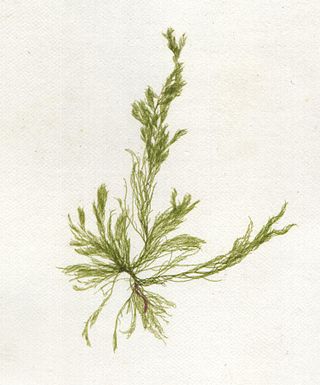Related Research Articles

Cladophora is a genus of reticulated filamentous Ulvophyceae. The genus Cladophora contains many species that are very hard to tell apart and classify, mainly because of the great variation in their appearances, which is affected by habitat, age and environmental conditions. Unlike Spirogyra the filaments of Cladophora branch and do not undergo conjugation. There are two multicellular stages in its life cycle – a haploid gametophyte and a diploid sporophyte – which look highly similar. The only way to tell the two stages apart is to either count their chromosomes, or examine their offspring. The haploid gametophyte produces haploid gametes by mitosis and the diploid sporophyte produces haploid spores by meiosis. The only visible difference between the gametes and spores of Cladophora is that the gametes have two flagella and the spores have four. The Cladophora species can be a major nuisance causing major alteration to benthic conditions linked particularly with increased phosphorus loading.
Pinguiochrysidaceae is a family of marine Heterokontophyta. It is the only family in the order Pinguiochrysidales, which is the only order in the class Pinguiophyceae. It includes five species of unicellular organisms with high concentration of polyunsaturated fatty acids in the cytoplasm. The other common features are the lack of cell wall and the tendency for flagella loss even on the stage of zoospore, which is unusual for heterokonts. One species inhabits benthic substates and is able to produce lorica with one or more tubular necks. The other species live in the plankton.
Croceitalea is a genus in the phylum Bacteroidota (Bacteria).

Cocconeis is a genus of diatoms. Members of the genus are elliptically shaped diatoms.
Roseitalea porphyridii is a Gram-negative and strictly aerobic bacterium from the genus Roseitalea that has been isolated from the alga Porphyridium marinum in Korea.
Litorimonas cladophorae is a Gram-negative, strictly aerobic and rod-shaped bacterium from the genus of Litorimonas which has been isolated from the alga Cladophora stimpsoni.
Pibocella is a Gram-negative heterotrophic and aerobic genus of bacteria from the family of Flavobacteriaceae with one known species Pibocella ponti. Pibocella ponti has been isolated from the alga Acrosiphonia sonderi.
Algitalea is a Gram-negative, strictly aerobic, rod-shaped, non-spore-forming genus of bacteria from the family of Flavobacteriaceae with one known species. Algitalea ulvae has been isolated from the alga Ulva pertusa.
Citreitalea is a Gram-negative, strictly aerobic and rod-shaped genus of bacteria from the family of Flavobacteriaceae with one known species. Citreitalea marina has been isolated from the marine alga Chondrus ocellatus.
Flavihalobacter is a Gram-negative, aerobic, rod-shaped and non-motile genus of bacteria from the family of Flavobacteriaceae with one known species. Flavihalobacter algicola has been isolated from the alga Saccharina japonica from Weihai.
Lacinutrix algicola is a Gram-negative, aerobic and heterotrophic bacterium from the genus of Lacinutrix which has been isolated from a red alga.
Lacinutrix chionocetis is a Gram-negative, aerobic, rod-shaped and non-motile bacterium from the genus of Lacinutrix which has been isolated from the gut of a red snow crab.
Lacinutrix gracilariae is a Gram-negative, aerobic and rod-shaped bacterium from the genus of Lacinutrix which has been isolated from the alga Gracilaria sp.
Lacinutrix iliipiscaria is a Gram-negative and rod-shaped bacterium from the genus of Lacinutrix which has been isolated from the intestine of a flounder.
Lacinutrix jangbogonensis is a Gram-negative, strictly aerobic, rod-shaped, psychrophilic and non-motile bacterium from the genus of Lacinutrix which has been isolated from marine sediments from the Ross Sea.
Lacinutrix salivirga is a Gram-negative, strictly aerobic, rod-shaped and motile bacterium from the genus of Lacinutrix which has been isolated from seawater from Korea.
Lacinutrix undariae is a Gram-negative, aerobic and non-motile bacterium from the genus of Lacinutrix.
Lacinutrix venerupis is a Gram-negative, strictly aerobic and non-motile bacterium from the genus of Lacinutrix which has been isolated from clams from Galicia in Spain.
Pseudozobellia is a Gram-negative and aerobic genus of bacteria from the family of Flavobacteriaceae with one known species. Pseudozobellia thermophila has been isolated from the alga Ulva fenestrata.
Ulvibacterium is a Gram-negative, aerobic, rod-shaped and non-motile genus of bacteria from the family of Flavobacteriaceae with one known species. Ulvibacterium marinum has been isolated from the alga Ulva prolifera.
References
- 1 2 "Species: Lacinutrix cladophorae". lpsn.dsmz.de.
- 1 2 Nedashkovskaya, Olga I.; Kim, Song-Gun; Zhukova, Natalia V.; Lee, Jung-Sook; Mikhailov, Valery V. (1 November 2016). "Lacinutrix cladophorae sp. nov., a flavobacterium isolated from the green alga Cladophora stimpsonii, transfer of Flavirhabdus iliipiscaria Shakeela et al. 2015 to the genus Lacinutrix as Lacinutrix iliipiscaria comb. nov. and emended description of the genus Lacinutrix". International Journal of Systematic and Evolutionary Microbiology. 66 (11): 4339–4346. doi: 10.1099/ijsem.0.001353 .